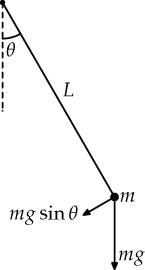Pendulum

A pendulum is a mass (any object usually metal) on an arm. The arm is attached to a pivot, which is a point to swing from. The mass will naturally hang down because of gravity, but if it is pushed to one side it will oscillate, which means that it will swing from side to side. The frequency of the swinging pendulum stays the same.
We can work out the time taken for one full oscillation (for example, swinging from left to right and back to left). We shall call this time the period. If the pendulum length is , and the acceleration due to gravity is , then:
where π (a Greek letter pronounced 'pi') is a mathematical constant. This equation gives a good approximation for the period when the mass does not swing far from the middle. The period of a pendulum does not depend on the mass of the object.
The mechanical energy of a pendulum is constant and is the sum of the kinetic energy and gravitational potential energy.
The regular motion of the pendulum can be used for timekeeping, and pendulums are used to regulate pendulum clocks.




